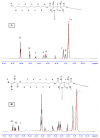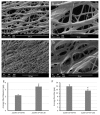New Three-Dimensional Poly(decanediol-co-tricarballylate) Elastomeric Fibrous Mesh Fabricated by Photoreactive Electrospinning for Cardiac Tissue Engineering Applications
- PMID: 30966490
- PMCID: PMC6415264
- DOI: 10.3390/polym10040455
New Three-Dimensional Poly(decanediol-co-tricarballylate) Elastomeric Fibrous Mesh Fabricated by Photoreactive Electrospinning for Cardiac Tissue Engineering Applications
Abstract
Reactive electrospinning is capable of efficiently producing in situ crosslinked scaffolds resembling the natural extracellular matrix with tunable characteristics. In this study, we aimed to synthesize, characterize, and investigate the in vitro cytocompatibility of electrospun fibers of acrylated poly(1,10-decanediol-co-tricarballylate) copolymer prepared utilizing the photoreactive electrospinning process with ultraviolet radiation for crosslinking, to be used for cardiac tissue engineering applications. Chemical, thermal, and morphological characterization confirmed the successful synthesis of the polymer used for production of the electrospun fibrous scaffolds with more than 70% porosity. Mechanical testing confirmed the elastomeric nature of the fibers required to withstand cardiac contraction and relaxation. The cell viability assay showed no significant cytotoxicity of the fibers on cultured cardiomyoblasts and the cell-scaffolds interaction study showed a significant increase in cell attachment and growth on the electrospun fibers compared to the reference. This data suggests that the newly synthesized fibrous scaffold constitutes a promising candidate for cardiac tissue engineering applications.
Keywords: biocompatibility; cardiac tissue engineering; particulate leaching; photo-crosslinking; poly(diol-tricarballylate); reactive electrospinning.
Conflict of interest statement
The authors declare no conflict of interest.
Figures







Similar articles
-
Development of an in-process UV-crosslinked, electrospun PCL/aPLA-co-TMC composite polymer for tubular tissue engineering applications.Acta Biomater. 2016 May;36:231-40. doi: 10.1016/j.actbio.2016.03.013. Epub 2016 Mar 8. Acta Biomater. 2016. PMID: 26969522
-
Overview of Tissue Engineering and Drug Delivery Applications of Reactive Electrospinning and Crosslinking Techniques of Polymeric Nanofibers with Highlights on Their Biocompatibility Testing and Regulatory Aspects.Pharmaceutics. 2023 Dec 26;16(1):32. doi: 10.3390/pharmaceutics16010032. Pharmaceutics. 2023. PMID: 38258043 Free PMC article. Review.
-
Synthesis, characterization & cytocompatibility of poly (diol-co-tricarballylate) based thermally crosslinked elastomers for drug delivery & tissue engineering applications.Mater Sci Eng C Mater Biol Appl. 2018 Dec 1;93:254-264. doi: 10.1016/j.msec.2018.07.028. Epub 2018 Jul 17. Mater Sci Eng C Mater Biol Appl. 2018. PMID: 30274057
-
Zein/Poly(3-hydroxybutyrate-co-4-hydroxybutyrate) electrospun blend fiber scaffolds: Preparation, characterization and cytocompatibility.Mater Sci Eng C Mater Biol Appl. 2017 Feb 1;71:797-806. doi: 10.1016/j.msec.2016.10.053. Epub 2016 Oct 26. Mater Sci Eng C Mater Biol Appl. 2017. PMID: 27987775
-
A review of evolution of electrospun tissue engineering scaffold: From two dimensions to three dimensions.Proc Inst Mech Eng H. 2017 Jul;231(7):597-616. doi: 10.1177/0954411917699021. Epub 2017 Mar 28. Proc Inst Mech Eng H. 2017. PMID: 28347262 Review.
Cited by
-
One-Step Fabrication of Porous Membrane-Based Scaffolds by Air-Water Interfacial Phase Separation: Opportunities for Engineered Tissues.Membranes (Basel). 2022 Apr 23;12(5):453. doi: 10.3390/membranes12050453. Membranes (Basel). 2022. PMID: 35629779 Free PMC article.
-
Fabrication of PCL Scaffolds by Supercritical CO2 Foaming Based on the Combined Effects of Rheological and Crystallization Properties.Polymers (Basel). 2020 Apr 2;12(4):780. doi: 10.3390/polym12040780. Polymers (Basel). 2020. PMID: 32252222 Free PMC article.
-
Generation of Novel Tumour-Selective SEA Superantigen-Based Peptides with Improved Safety and Efficacy for Precision Cancer Immunotherapy.Int J Mol Sci. 2024 Aug 30;25(17):9423. doi: 10.3390/ijms25179423. Int J Mol Sci. 2024. PMID: 39273378 Free PMC article.
-
The Use of Bioactive Polymers for Intervention and Tissue Engineering: The New Frontier for Cardiovascular Therapy.Polymers (Basel). 2021 Jan 30;13(3):446. doi: 10.3390/polym13030446. Polymers (Basel). 2021. PMID: 33573282 Free PMC article. Review.
-
The Effect of Solvent Vapor Annealing on Drug-Loaded Electrospun Polymer Fibers.Pharmaceutics. 2020 Feb 6;12(2):139. doi: 10.3390/pharmaceutics12020139. Pharmaceutics. 2020. PMID: 32041349 Free PMC article.
References
-
- GUSTO Angiographic Investigators The effects of tissue plasminogen activator, streptokinase, or both on coronary-artery patency, ventricular function, and survival after acute myocardial infarction. N. Engl. J. Med. 1993;329:1615–1622. - PubMed
-
- Cheng Y., Yi G., Conditt G.B., Sheehy A., Kolodgie F.D., Tellez A., Polyakov I., Gu A., Aboodi M.S., Wallace-Bradley D., et al. Catheter-based endomyocardial delivery of mesenchymal precursor cells using 3d echo guidance improves cardiac function in a chronic myocardial injury ovine model. Cell Trans. 2013;22:2299–2309. doi: 10.3727/096368912X658016. - DOI - PubMed
-
- Ripa R.S., Jorgensen E., Wang Y., Thune J.J., Nilsson J.C., Sondergaard L., Johnsen H.E., Kober L., Grande P., Kastrup J. Stem cell mobilization induced by subcutaneous granulocyte-colony stimulating factor to improve cardiac regeneration after acute st-elevation myocardial infarction: Result of the double-blind, randomized, placebo-controlled stem cells in myocardial infarction (stemmi) trial. Circulation. 2006;113:1983–1992. - PubMed
Grants and funding
LinkOut - more resources
Full Text Sources

